Agile marketing and business agility often begin with a single, mighty pilot team. It then grows to encompass more teams, a department, and, if we’re very lucky, maybe even an entire Agile organization.
As the mindset takes hold, each group’s practices and success metrics evolve.
Execution teams will likely focus on breaking down larger projects into their actionable pieces and monitoring the daily workflow of their own team.
Leaders, on the other hand, are managing an array of projects across many teams. They’ll want to see a bird’s eye view of the progress from various execution teams.
These interests are related, but they don’t always intersect.
Leaders need to keep their finger on the pulse of overarching organizational strategy, while execution teams need to monitor day-to-day task management.
Even though the goals of each group may seem different, they can both make use of Agile tools such as visual boards, workflows, and Agile metrics to make sure they are achieving organizational goals.
The differences in the way each layer of the organization implements these tools will come down to how each group approaches work breakdown and how granular their work items within the flow will be.
Then, it’s all about connecting the two systems so they reflect and affect each other in a meaningful way.
Here’s how to make that happen IRL.
It All Starts At the Planning Stage
One of the worst misconceptions about Agile is that it abandons planning entirely. This is what leads many to assume that Agile HLS or BFSI marketing is an oxymoron. The reality is that planning is integral to well-functioning Agile marketing. In fact, one of the key benefits of the visualization we're discussing here is eliminating costly unplanned work.
When it comes to executing this kind of planning and visualization, whether you're on the strategic level or the tactical level, you’re likely to be involved in some project planning.
Strategic Planning
On an annual or half-year basis, marketing leaders develop the base for the marketing roadmap ahead. At this stage, they do not explore the tactics required to execute it in detail. Leadership and executives will develop the vision for the department or organization.
Also at this level the more specific initiatives that each team in the department will tackle over the course of the year will be outlined. The teams and their leaders will prioritize and break down that work later.
As work commences, leaders will continue to have an interest in tracking whether the vision is being achieved and initiatives are moving forward as planned. After all, they’re accountable for deliverables at the strategic level.
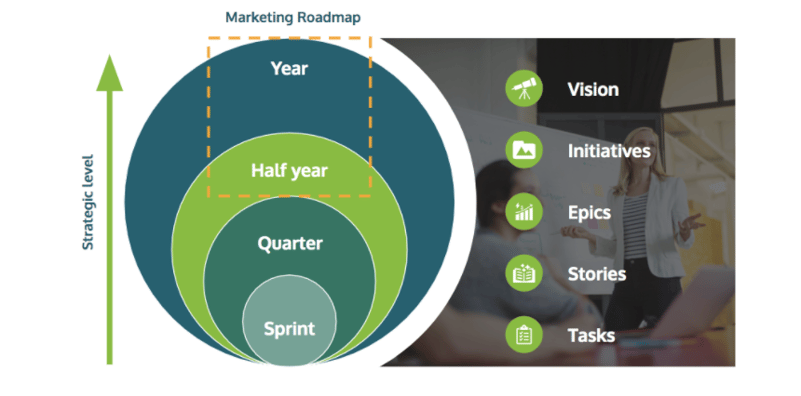
Tactical Planning
Once the Vision and Initiatives have been defined by leadership, execution teams will then continue the Agile planning process by breaking them down into even more granular pieces.
Execution team members are the members of the Agile organization that are closest to the work. They use their insight to transform more abstract initiatives into detailed epics (e.g. marketing campaigns or programs). Further, they break down the epics into actionable user stories and tasks.
That way, the work becomes more grounded in reality for the people whose job it will be to execute it.
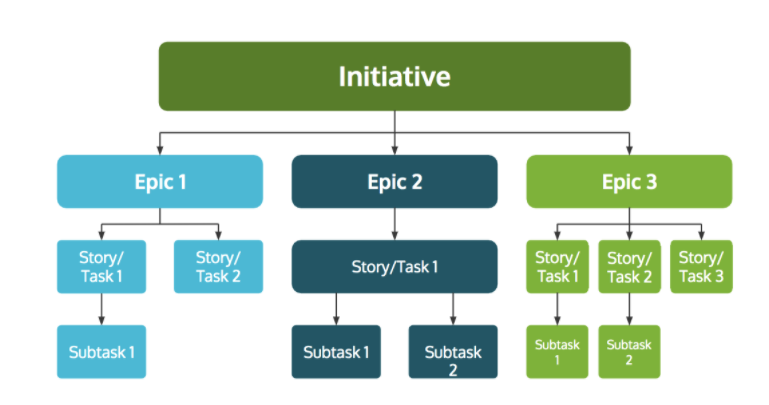
The planning on both levels of the organizational hierarchy is equally important.
Splitting planning responsibilities this way allows each group to track progress at the level of granularity that’s most closely aligned to their work.
Note: The Vision and Initiative levels of planning may not be subject to many changes throughout the year. These will make up the backbone of the Marketing Roadmap throughout the year. However, how these initiatives get achieved may change and adapt according to changes in the environment.
For example, epics, stories, and the tasks required to execute them may shift and react to any number of new developments. For example, changing customer demands or emerging competitors, may prompt tactical teams to change course.

Before proceeding to learn the difference between strategic & tactical visual workflows, why don't you take a second to get our guide on choosing an Agile trailhead?
Strategic vs Tactical Visual Workflows in Agile Organizations
Once each group has broken down its responsibilities, both leaders and execution teams can map the elements they’re accountable for to a visual workflow, no matter their scale.
Leaders may have a small prioritized backlog of large-scale initiatives, while execution teams will have a much larger stacked backlog of tasks and user stories from which they can pull.
In both cases, a Kanban board is an appropriate tool to visualize each workflow.
Portfolio Kanban Board vs Team Kanban Board
In the Kanban universe, there are two major types of Kanban boards. One structure is more suited to management of the entire portfolio of initiatives (for leaders). The other is more appropriate for daily task management (for the teams).
The Tactical Board
The daily team Kanban board’s process phases will reflect the steps work needs to go through within the team itself. It can be as simple or as detailed as the team requires. In most cases, work as granular as user stories, tasks, and subtasks lives on the board and will flow through this system.
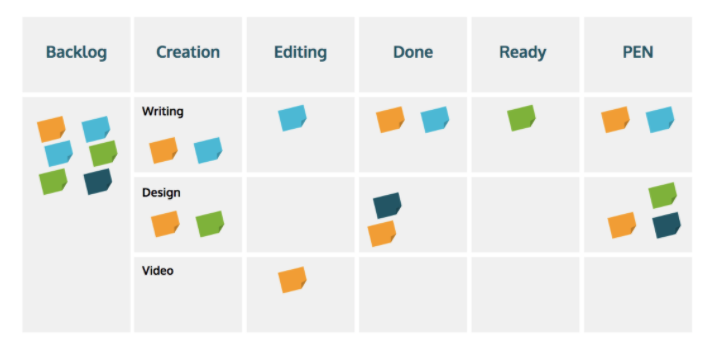
The Strategy Board
On the strategic level, the Kanban board is likely to have a more simple structure. A Kanban board that tracks an entire portfolio of projects on the department or organizational level is called a portfolio Kanban.
In a typical portfolio Kanban structure, columns such as Not Started, 50% Complete, 75% Complete and Done signify how close an entire initiative is to completion based on the progress of the execution teams.
The completion of initiatives depends on several teams and leaders equally. That is why those making movements on the strategic level will look to the execution boards to determine the progress of each of their overarching initiatives.
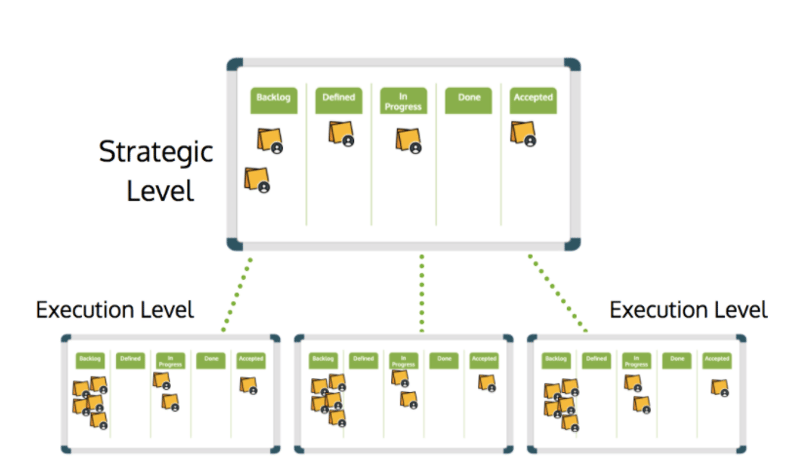
For example, an Initiative on the portfolio Kanban will only move to the column “50% Complete” when half the tasks associated with it on the execution level are also marked “Complete” on the team Kanban boards.
Portfolio Kanban boards can reflect and summarize the progress made by a number of execution teams working in parallel. This allows for up-to-date alignment between the strategy and execution layers of the organization on a daily or weekly basis.
Epic Burndown vs Sprint Burndown
In a Scrum team environment, the burndown chart can reflect progress on committed work over the course of each individual sprint by calculating team velocity. In this case, the burndown tracks the set of story points the team commits to for a single sprint during the 2-4 week active working period. Then, the sprint ends and the burndown chart restarts.
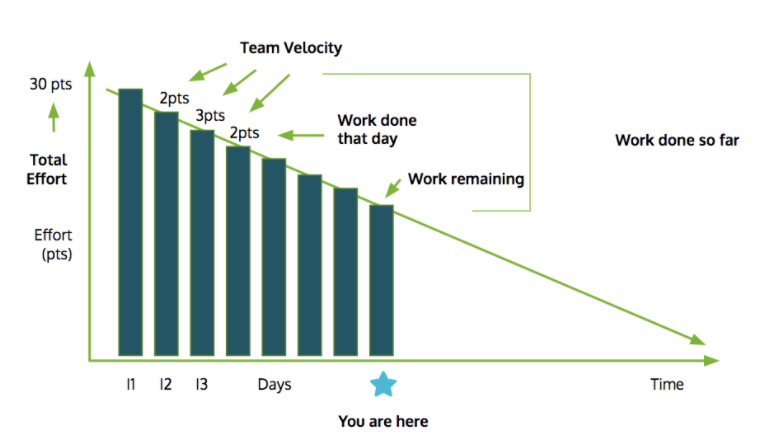
Alternatively, the burndown chart can encompass a series of sprints and show an ongoing burndown on the epic level. While this view may be relevant to the execution team as well, it is even more important to leadership.
The epic (or marketing campaign/program) level burndown chart tracks the completion of epics over the course of an entire version. A single version might consist of tens of sprints. As it does not restart, leadership has a bird’s eye view of team progress, instances of scope change and forecasting capabilities across sprints.
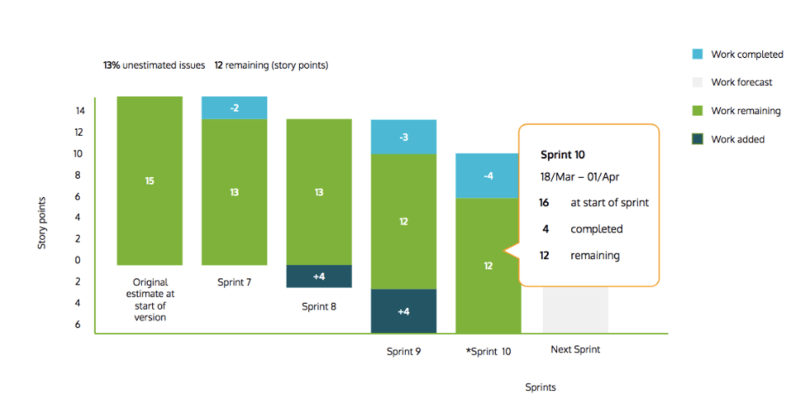
Connecting Strategy and Execution in Your Agile Organization
Keeping both views up to date becomes crucial as ongoing projects move closer to completion. In most organizations, key decisions regarding objectives will be made using information from the portfolio level visualization that has been influenced by the activities of the execution teams.
If This, Then That
When using digital tools for process visualization, it’s possible to connect both views so that Done tasks on the execution level can affect the portfolio visualization in the strategic view.
Automating this process will ensure the portfolio view consistently reflects the progress (and, in some cases, delays) from the execution teams.
If This Then That and Zapier are services you can make use of to hook your two visualizations together. Both can create a basic connection between the tactical and the strategic workflows. In effect, changes made on the execution level will reflect on the portfolio level in real time.
Other, more sophisticated, workflow visualization tools also have automated business rules built-in for this purpose.
Accessibility and Shared Understanding in Agile Organizations
Not able to automatically connect your strategic and tactical visualizations from the start? Begin by making them accessible to as many relevant parties as necessary. Creating shared understanding about how daily tasks align up to strategic initiatives for the business is crucial. It will facilitate valuable conversations that affect both leadership and executions teams equally.
Create accessibility and shared understanding on all levels by:
- Creating opportunities for keeping both visualizations up to date. Introduce a weekly check-in between reps from the execution teams and leaders who are updating the visualization of initiatives.
- Making both visualizations available using a digital tool. Alternatively, use a physical Kanban boards in a shared workspace.
- Including both levels in the initial planning using popular Agile formats like Big Room Planning. This will help manage expectations from the moment work commences. It will also make forecasting for both leaders and execution teams easier. Planning together eliminates confusion created as work breaks down from marketing roadmap to daily task management.
Are you already making use of strategic and tactical workflow visualizations to keep leaders and execution teams aligned around organizational OKRs? Do both levels reflect current reality or are they out of date?
No matter how you choose to start using this valuable Agile practice, communication is key.
Keep all levels in the loop. Keep your visualizations up to date. Convey project status using simple visual boards for best results. If keeping up with it all is still a struggle, consider Agile marketing training and coaching to help work through your challenges.
Before moving on, don't forget to get your copy of our Choosing an Agile Trailhead Guide.